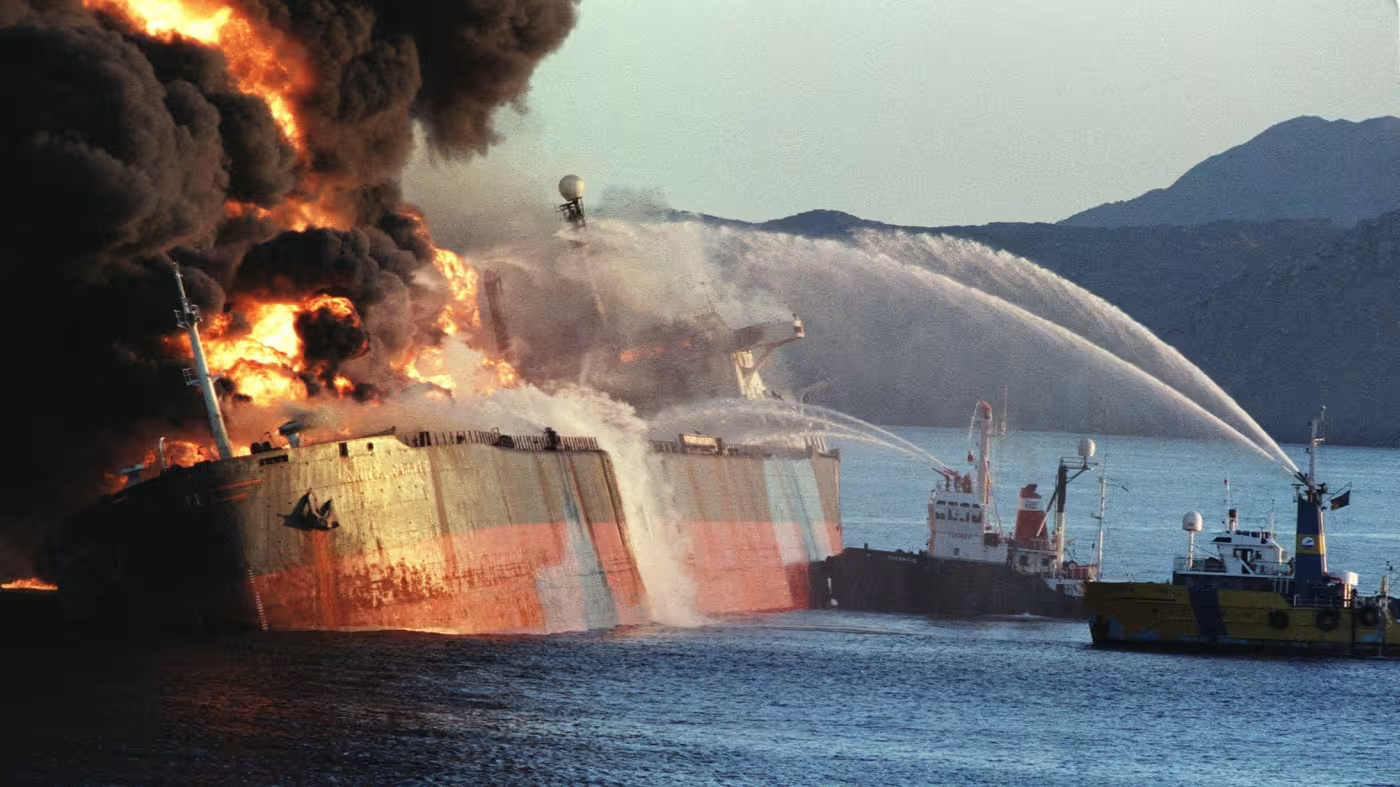Discover how Iran strategically influenced the outcome of the Tanker War (1981–1988) in the Persian Gulf and Strait of Hormuz. Explore military tactics, economic impacts, maritime risks, and lessons for today’s shipping industry.
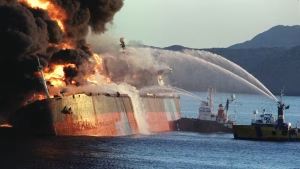
Why the Tanker War Matters in Modern Maritime Operations
The Tanker War was not just a regional conflict. It redefined maritime security, reshaped naval doctrines, and revealed the vulnerabilities of global trade routes. From 1981 to 1988, during the height of the Iran-Iraq War, the Persian Gulf became one of the most dangerous waters for merchant shipping. With nearly 450 commercial vessels attacked and millions of barrels of oil disrupted, the war offered a sobering lesson: oil chokepoints like the Strait of Hormuz could be militarized with asymmetric tactics.
For today’s maritime professionals, this chapter of history is more than academic. As geopolitical tensions flare across the Gulf of Oman, South China Sea, and Red Sea, the Tanker War remains a blueprint for hybrid naval warfare.
Setting the Stage: What Was the Tanker War?
The Tanker War was a sub-conflict of the larger Iran-Iraq War. Beginning in earnest in 1984, both nations began targeting oil tankers and merchant ships to cripple each other’s economic lifelines. Iraq attacked Iranian oil exports using French-supplied Mirage jets and Exocet missiles. In response, Iran retaliated not only against Iraqi shipping but also vessels of Gulf states supporting Iraq, such as Kuwait and Saudi Arabia.
At its core, the Tanker War was economic warfare played out on the high seas. The battlefield was the Persian Gulf, and the targets were often neutral vessels caught in the geopolitical crossfire.
Iran’s Strategy: Asymmetry Over Firepower
Unlike Iraq, which relied on long-range missile strikes and conventional aircraft, Iran adapted a more asymmetric approach. With limited access to advanced naval technology (due to sanctions and isolation), Iran relied on:
- Speedboats and fast attack craft: Operated by the IRGC Navy (Islamic Revolutionary Guard Corps), these vessels conducted swarm attacks on tankers, laying mines and launching rockets.
- Naval mines: Iran laid hundreds of mines near key maritime routes, particularly around Farsi Island and the northern Gulf.
- Coastal missile batteries and sea-based helicopters: Deployed to threaten or harass shipping lanes.
- Psychological operations: Iran mastered the use of unpredictability, creating a sense of constant threat without needing overwhelming force.
This strategy exploited the Gulf’s geography. The narrowness of the Strait of Hormuz (only 21 nautical miles wide at its narrowest) gave Iran the tactical advantage. By maintaining shore-based assets and hit-and-run naval tactics, Iran effectively raised the cost of doing business for any adversary.
The Impact on Shipping: Data and Risk
According to Lloyd’s List Intelligence and declassified US Navy reports, approximately 411 merchant ships were damaged during the conflict. Notably:
- 1987: Marked the peak, with over 100 vessels attacked in a single year.
- 1984-1988: 55% of attacks were against neutral or third-party vessels, highlighting the indiscriminate nature of the threat.
- Insurance premiums soared. By late 1986, war-risk premiums for ships in the Gulf increased by up to 300%, according to UNCTAD.
- Some shipowners re-flagged under neutral nations (especially the US and Soviet Union) to gain naval escorts.
Iran’s strategy worked: oil shipments slowed, freight prices climbed, and Gulf Cooperation Council (GCC) states were forced to seek foreign naval protection.
Escalation and the Reflagging Crisis
In 1987, Kuwait requested help from global powers to protect its oil exports. The US responded by reflagging 11 Kuwaiti tankers under the American flag in Operation Earnest Will. These vessels were escorted by US Navy warships through the Gulf.
But Iran saw this as a provocation.
- On May 17, 1987, the USS Stark was struck by a missile, killing 37 American sailors.
- In response, the US increased its naval presence in the Gulf and clashed directly with Iranian forces in Operation Praying Mantis (April 1988).
Despite this, Iran achieved strategic success. By compelling world powers to intervene, Tehran demonstrated that it could influence superpower naval deployments using relatively low-cost tactics.
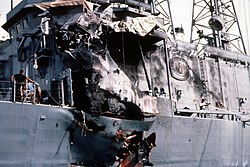
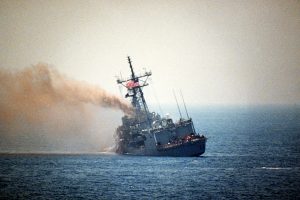
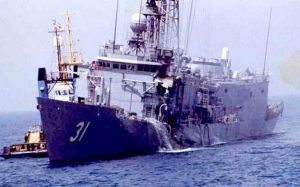
A port quarter view of the guided missile frigate USS STARK (FFG-31) listing to port after being struck by a launched Exocet missile.
How Iran Shifted the Balance
Iran did not “win” the Tanker War through domination or outright control of the Gulf. Instead, it forced a stalemate. Its real victory was in:
- Undermining Iraq’s oil export lifeline by consistently targeting tankers heading to and from Basra.
- Escalating the cost of neutrality: By targeting third-party vessels, Iran blurred lines and widened the conflict.
- Establishing deterrence: Iran’s mining campaign culminated in the damage to the USS Samuel B. Roberts, which triggered direct US retaliation. Even so, Tehran’s message was clear: the Gulf could be closed if needed.
Case Study: The Bridgeton Incident
On July 24, 1987, the reflagged Kuwaiti tanker Bridgeton struck an Iranian mine near Farsi Island while under US Navy escort. Though the damage was minimal, the symbolic impact was massive.
- The US Navy warships, sailing in a protective formation, had to fall in line behind the crippled Bridgeton.
- The incident showcased how even a low-tech tactic like mining could pierce high-tech defense systems.
This was perhaps the most visible example of how Iran’s asymmetric approach reshaped maritime security doctrine.
Lessons for Today’s Shipping and Naval Policy
The Tanker War continues to influence global naval thinking:
- Hybrid warfare is cost-effective: Iran demonstrated that a weaker navy can challenge a superior force using mines, speedboats, and psychological pressure.
- Sea lanes are inherently vulnerable: Especially in chokepoints like the Strait of Hormuz, Bab el-Mandeb, or Malacca.
- Maritime insurance must evolve: Risk premiums and route planning are deeply tied to geopolitical uncertainty.
- Naval deterrence requires adaptation: Today’s navies must prepare not just for open war, but for ambiguous threats from non-state actors, drones, and cyber.
Iran’s Post-1988 Strategy and Naval Doctrine
After the war, Iran institutionalized the tactics it developed. The IRGC Navy became the core guardian of the Gulf, while the regular Iranian Navy focused on blue-water operations. Notably:
- Iran developed smart mines and fast missile boats.
- It expanded its maritime drone capabilities.
- It increased training exercises in the Strait of Hormuz and Gulf of Oman.
These moves ensure that any future conflict in the Gulf will echo the dynamics of the Tanker War, albeit with modern technologies.
Is the Tanker War Still Relevant?
Absolutely. In 2019, two oil tankers were attacked near the Strait of Hormuz under mysterious circumstances. Iran was accused, though denied involvement. In 2023, drone strikes and mine attacks in the Red Sea again raised fears of a “Tanker War 2.0.”
For shippers, insurers, and navies, the lessons from 1981 to 1988 remain painfully current.
Frequently Asked Questions
What was the main goal of Iran during the Tanker War? Iran aimed to weaken Iraq’s economy, retaliate against Gulf states supporting Iraq, and deter foreign intervention in the conflict.
How many ships were damaged in the Tanker War? Roughly 411 merchant ships were attacked, with the majority occurring between 1984 and 1988.
Did Iran target only enemy ships? No. Iran often targeted neutral or third-party vessels, especially those linked to Iraq or its Gulf allies.
Why did the US escort Kuwaiti tankers? Kuwait requested protection, and the US agreed to reflag and escort its tankers under Operation Earnest Will to safeguard oil flows.
How did the war affect oil prices and insurance? War-risk insurance premiums rose sharply, and oil prices fluctuated due to insecurity in the Gulf.
Is Iran capable of repeating a similar strategy today? Yes, with more advanced technology including drones, cyberwarfare, and modern mines, Iran could pose a similar or greater threat in any future conflict.
Conclusion
Iran’s conquest of the Tanker War was not a traditional military triumph. It was a strategic victory rooted in patience, geography, and the art of disruption. By turning the Gulf into a maritime minefield of uncertainty, Tehran challenged global powers, reshaped naval strategies, and cemented its influence over one of the world’s most vital trade arteries.
Today, with tensions in the Middle East still high, the Tanker War serves as a vital case study in maritime resilience, geopolitical risk, and asymmetric naval warfare. The lessons remain as important for shipowners and insurers as they do for admirals and diplomats.
References
- UNCTAD Review of Maritime Transport (1989): unctad.org
- Lloyd’s List Intelligence Archive
- US Naval War College Review (1990), “The Tanker War and the Lessons for Naval Strategy”
- IISS Military Balance, 1987-1989
- The International Institute for Strategic Studies (IISS), London
- Britannica entry on Iran-Iraq War: britannica.com
- CRS Report for US Congress: “Iran’s Threat to the Strait of Hormuz”
- Marine Policy Journal, Elsevier (1989), Vol. 13, Issue 2
- Maritime Executive (2020), “Echoes of the Tanker War in the Gulf Today”
- International Journal of Maritime History
- MarineTraffic & Clarksons Research data on historic vessel routes and attacks

